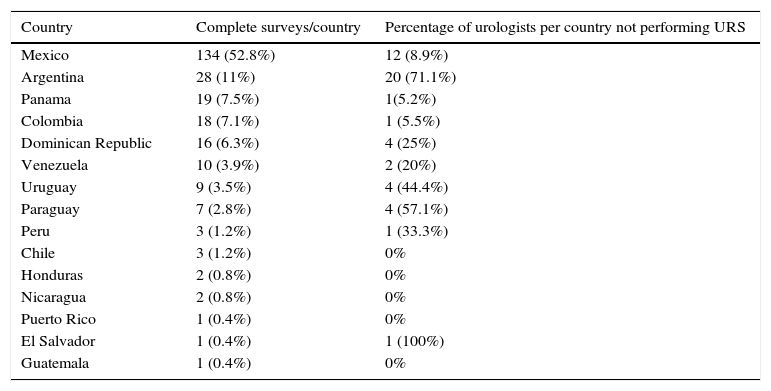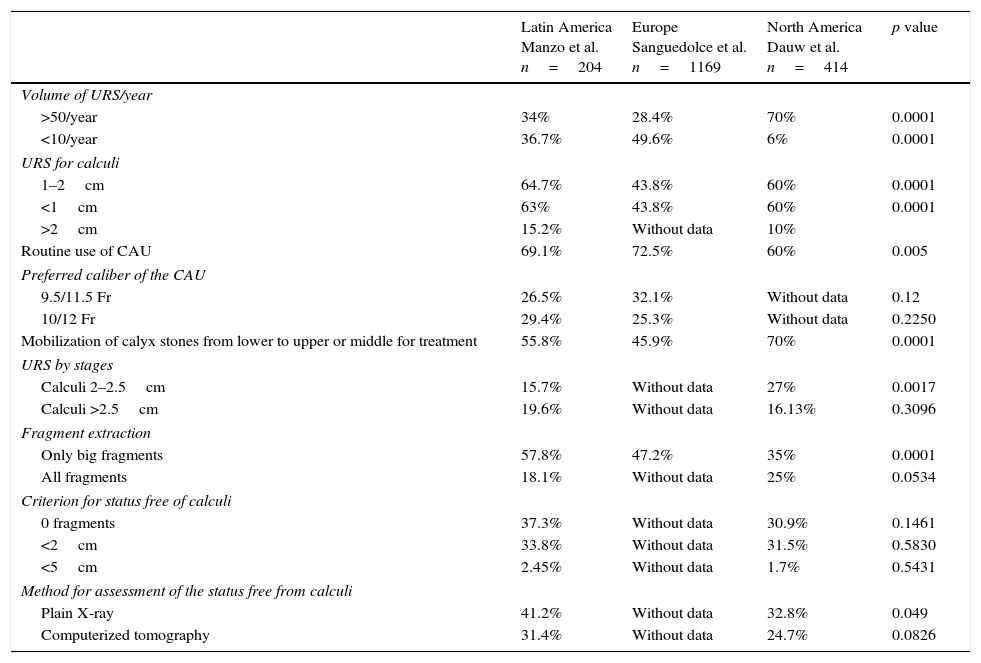The use of flexible ureterorenoscopy for treating kidney stones has increased in recent years, with considerable worldwide variation in the surgical technique and indications.
ObjectivesTo determine the current practice, technique variations, use and indications of flexible ureterorenoscopy for treating kidney stones in Latin American.
MethodsWe sent (by email and web link) an anonymous questionnaire with 30 questions on flexible ureterorenoscopy for treating kidney stones to Latin American urologists from January 2015 to July 2015. We collected the responses through the Survey Monkey system.
ResultsA total of 283 urologists in 15 Latin American countries participated (response rate, 10.8%); 254 answered the questionnaire completely; 52.8% were urologists from Mexico and 11% were from Argentina; 11.8% of the responders stated that they performed >100 cases per year; 15.2% considered ureterorenoscopy as the treatment of choice for stones >2cm, and 19.6% performed ureterorenoscopy in single stages for calculi measuring >2.5cm. Some 78.4% use fluoroscopy, 69.1% use a ureteral sheath in all cases, 55.8% place double-J catheters at the end of surgery, 37.3% considered a stone-free state to be 0 fragments, and 41.2% use plain radiography to assess the stone-free condition.
ConclusionsMost participating urologists consider flexible ureterorenoscopy as the first-choice treatment for stones <2cm; a small percentage of these urologists perform >100 ureterorenoscopies per year. More than half of the urologists routinely used fluoroscopy and ureteral access sheath; the most common method for determining the stone-free state is plain abdominal radiography.
Actualmente se ha incrementado la ureteronefroscopia flexible para el tratamiento de cálculos renales, existiendo gran variación en la técnica quirúrgica e indicaciones a través de todo el mundo.
ObjetivosConocer la práctica actual, variaciones en la técnica, uso e indicaciones de la ureteronefroscopia flexible para tratamiento de cálculos renales en Latinoamérica.
MétodosEnviamos un cuestionario anónimo de 30 preguntas sobre ureteronefroscopia flexible para el tratamiento de cálculos renales, vía correo electrónico y enlace Web a urólogos de Latinoamérica de enero de 2015 a julio de 2015. Recolectamos las respuestas a través del sistema Survey Monkey.
ResultadosParticiparon 283 urólogos de 15 países latinoamericanos (tasa de respuesta del 10,8%); 254 contestaron completamente el cuestionario; 52,8% son urólogos de México y 11% de Argentina, 11,8% realizan>100 casos por año, 15,2% consideran la ureteronefroscopia como tratamiento de elección para cálculos >2cm y 19,6% realiza ureteronefroscopia en etapas solo para cálculos>2,5cm. El 78,4% utiliza fluoroscopia, el 69,1% utiliza camisa ureteral en todos sus casos, el 55,8% deja el catéter doble J al final de la cirugía, el 37,3% considera estado libre de lito con 0 fragmentos y el 41,2% utiliza radiografía simple para evaluar el estado libre de cálculos.
ConclusionesLa mayoría de urólogos participantes considera la ureteronefroscopia flexible como el tratamiento de primera elección para cálculos<2cm, un pequeño porcentaje realiza >100 ureteronefroscopias por año. Más de la mitad utiliza fluoroscopia y camisa de acceso ureteral rutinariamente, el método más frecuente para la evaluación del estado libre de cálculos es la radiografía simple de abdomen.












